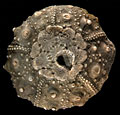The Echinoid Directory
Leptosalenia Smith & Wright, 1990, p. 134
| Diagnostic Features |
|
|---|---|
| Distribution | Cretaceous (Early Aptian to Turonian) of Europe, North America, North Africa, the Middle East and India. |
| Name gender | feminine |
| Type | Salenia prestensis Desor, 1856, by original designation. |
| Species Included |
|
| Classification and/or Status |
|
| Remarks |
|


